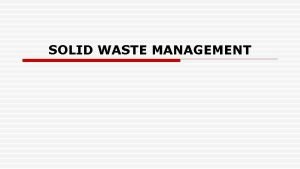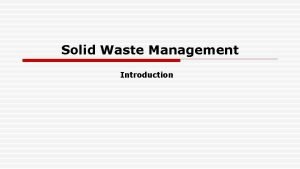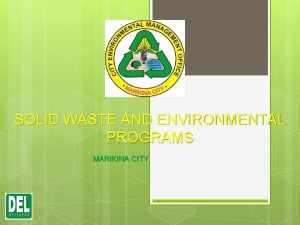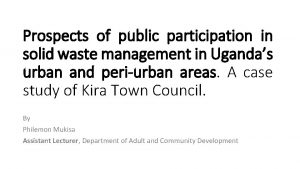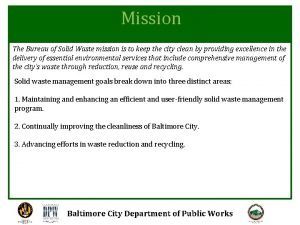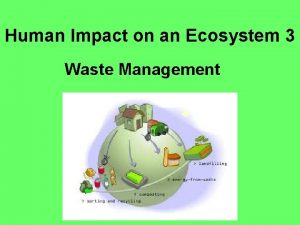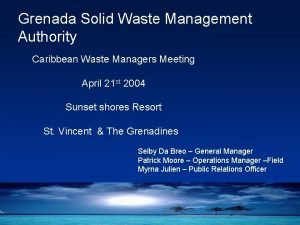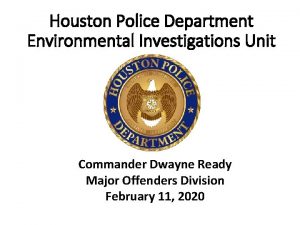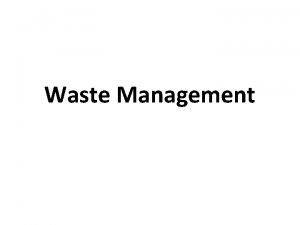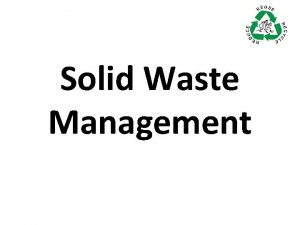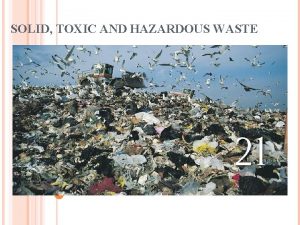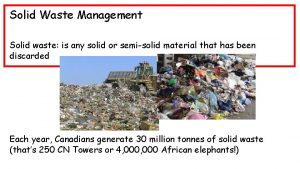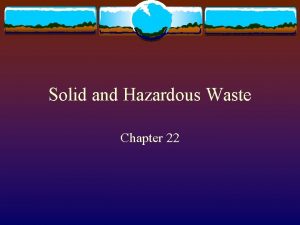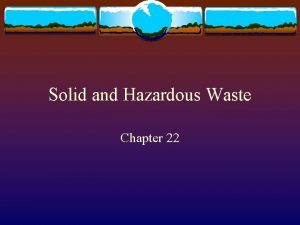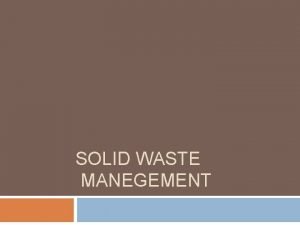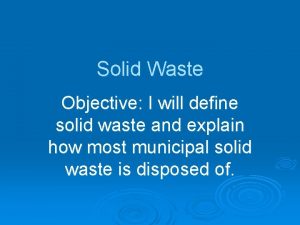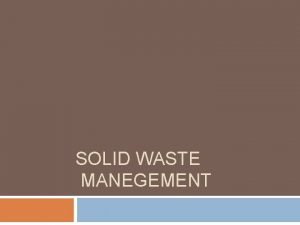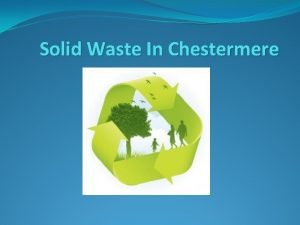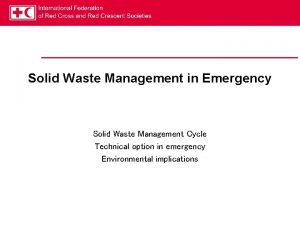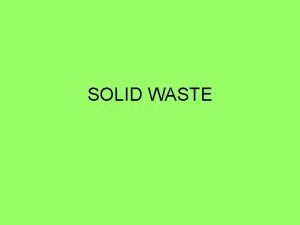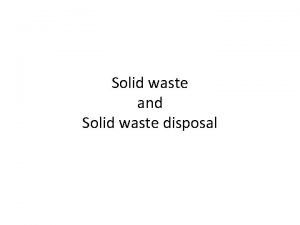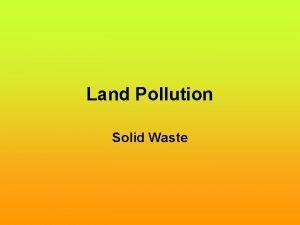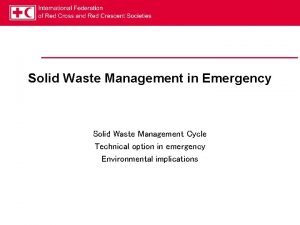Chapter 19 Waste 12 1 Solid Waste A



























- Slides: 27

Chapter 19 Waste

12. 1 Solid Waste • A. The Generation of Waste – Solid waste is any discarded solid material – Solid waste included: junk mail to coffee grounds to cars 1. Space and Waste – Many towns are running out of space to dispose of the amounts of waste that people create. 2. Population and Waste – Human populations and the amount to waste we produce grows larger – The amount of land available person becomes smaller. – Average person in the US produces 4. 4 pounds of solid waste per day. – It is getting harder to dispose of the waste we create.

B. Not All Wastes Are Equal – Biodegradable if it can be broken down b biological processes – Plant and animal matter are examples of biodegradable materials – Products made from natural materials are usually biodegradable such as newspaper, paper bags, • 1. Plastic Problems – Plastic is an example of nonbiodegradable material – Plastics that we throw away ma accumulate and last for hundreds of years.

C. Types of Solid Waste • Municipal solid waste is most of what we throw out on a day-to day basis. • Manufacturing waste and mining wasted make up about 70 % of the other types of solid wastes produced in the US. 1. Municipal solid Waste – Municipal solid waste which is the waste produced by households and businesses – This is about 2% of the total solid waste in US and amount to 236 million tons each year. – The amount of municipal solid waste is growing faster than the amount of mining or agricultural waste. 2. Solid Waste from Manufacturing, Mining, and Agriculture – Solid waste from manufacturing, mining, and agriculture make up most of the rest of the total waste produced in the US. – This includes scrap metal, plastics, paper, sludge, and ash.

D. Solid Waste Management • Most municipal waste is sent to land fills • Now about 30% of waste is recycled 1. Landfills – More than 50% of the municipal and manufacturing solid waste created in the US ends up in landfills – A landfill is a permanent waste-disposal facility where wastes are put in the ground and covered each day with a layer of soil, plastic or both


2. Problems with Landfills – – – Leachate is a liquid that has passed through compacted solid waste in a landfill Leachate forms when water seeps down through a land fill and collects dissolved chemicals from the decomposing garbage If landfills are not monitored properly the Leachate can flow into groundwater supplies and make water from nearby wells unsafe to drink Second problem with landfills is the production of methane (a flammable gas) Methane can seep through the ground and into basements of homes up to 300 meters from landfill

3. Safeguarding Landfills – New landfills must be land with clay and plastic linger and have systems for collecting and treating Leachate. – Adding safeguards increases the cost of building them. – Also find acceptable places to build landfills is difficult 4. Building More Landfills – We are currently running out of space to build new landfills – In 2005 the total number of landfills in US was 1, 700 – The EPA estimates that the active landfills in 20 states will be filled to capacity within 10 years.

5. Incinerators – One options to reduce the amount of solid waste sent to landfills it to burn it in incinerators. – Incinerator can reduce the weight of solid waste by 75% – But cannot separate the maters that should not be burned (cleansers, batteries, and paints – These items end up as air polluting gases – The incarnated material takes up less space in landfill but is more toxic.

How incinerators work

19. 2 Reducing solid Waste • Source Reduction is any change in design, manufacture, purchase, or use of materials or product to reduce their amount or toxicity before they become municipal solid waste • Reducing Solid Waste • 1. Buying Less – Buy products that have less packing, products that last longer, or reusable products – For example if consumers bought products in refillable bottles beverage manufacturers would begin producing with the refillable bottles. • 2. Lasting Longer – A return to products that last longer and are designed to be easily repaired would both save resources and reduce waste disposal

Recycling is the process of reusing materials or recovering valuable materials from waste or scrap. • 1. Recycling: A series of Steps – 1 st the discarded materials must be collected and sorted by type – 2 nd each type of material must be taken to a facility where it can be cleaned and made ready to be used again • For example: glass is sorted by color and is crushed, paper is sorted by type and made into a pulp with water – 3 rd the materials are used to manufacture new product – 4 th the new products are sold to consumers – If more people buy products made from recycled materials there would be an increase in the demand for these products

Composting – Yard waste makes up more than 15 percent of a community’s solid waste – Yard waste is biodegradable and does not need to go to a landfill – Compost a dark brown, crumbly material made form decomposed plant and animal matter that is spread on gardens and fields to enrich the soil. – Compost is rich in the nutrients that help plants grow – If all biodegradable wastes were composted the amount of solid waste going to landfills could be reduced.

Changing the Materials We Use • Changing the materials we use could eliminate much of the solid waste we produce • Most of our waste could be recycled if such products were made of recyclable glass, cardboard, or aluminum containers

a. Degradable Plastics • Photodegradable plastic is made so that when left in the sun it becomes weak and brittle and eventually breaks into pieces • Green plastic is made by blending the sugars in plants with a chemical agent to make plastic • Green plastic is designed to degrade within 45 days of being thrown away b. Problems with Degradable Plastics • The plastic parts of degradable plastics remain but only in smaller pieces. • Biodegradable plastics can remain in landfills for many years just like regular plastics

12. 3: Hazardous Waste Hazardous waste is any waste that is a risk to the health of humans or other living things A. Types of Hazardous Waste • Hazardous wastes may be solids, liquids, or gases • Often contain toxic, corrosive, or explosive materials • Federal laws were passed o clean up old waste sites and regulate future waste disposal B. Resource Conservation and Recovery Act • The Resource Conservation and Recovery Act (RCRA) requires producers of hazardous waste to keep records of how their wastes are handled • If the waste cause a problem in the future the producer is legally responsible for the problem.

C. The Superfund Act • Safe disposal for hazardous waste is expensive and companies may be tempted to illegally dump them to save money. • 1980 the congress passed the Comprehensive Environmental Response, compensation and Liability Act (also called the superfund act) • This act gives the EPA the right to sue the owners of hazardous waste sites who had illegally dumped waste. • Superfund act created a fund of money to pay for cleaning up abandoned hazardous waste sites. • As of 2001 only 75% of the sites had been cleaned up.

Superfund Sights in US

D. Hazardous Waste Management • 252 million metric tons of hazardous waste is produced by US each year 1. Preventing Hazardous Waste • One way to prevent hazardous waste is to produce less of it • Many manufacturers have discovered they can redesign manufacturing methods to produce less or no hazardous waste. • Another way to deal with waste is to find a way to reuse it

2. Conversion into Nonhazardous Substances • Some types of wastes can be treated with chemicals to make them less hazardous. • Treat acids with lime (a base) to form a salt which is less harmful to environment • Sludge from petroleum refineries may be converted by soil bacteria into less harmful substances. 3. Land Disposal • Most hazardous waste is disposed of on land in a deep -well injection • Deep-well injection is where wastes are pumped deep into the ground absorbed into a dry layer of rock below the level of groundwater. The wastes are covered with cement to prevent contaminating of the groundwater.

Deep-well injection facility diagram

• Surface impoundment (another land disposal facility) is basically a pond that has a sealed bottom. The waste accumulates and settles to the bottom of the pond and the water evaporates from the pond. • Hazardous wastes in concentrated or solid form are often put into barrels and buried in landfills • If maintained they should provide safe ways to dispose of hazardous wastes. • If not maintained they can leak and contaminate the air, soil, or groundwater.

4. Biologically Treating Hazardous Waste • Some hazardous waste can be absorbed, broken down, or their toxicity reduced when treated with biological and chemical agents. • Certain bacteria can be used to clean up an area that has been contaminated with hazardous substance • Chemicals can be used to neutralize and absorb hazardous wastes

5. Incinerating Hazardous Wastes • Some hazardous wastes are disposed by burning • Incineration is generally the most expensive form of waste disposal • They need pollution control devices and be carefully monitored • Left over ash must be buried 6. Exporting Hazardous Waste • Companies would get rid of hazardous waste by sending them to landfills in other states • Some hazardous wastes are exported to other countries because they have the facilities to deal with the waste

E. Hazardous Wastes at Home • Chemicals such as paint, pesticides, and batteries all create hazardous waste • Hazardous materials poured down the drain or put in the trash end up in solidwaste landfills • They should be disposed of in a hazardous waste landfill

1. Disposing of Household Hazardous Waste • Many cities have began to provide collection for household hazardous waste • Used batteries and motor oil are recycled • Paint can be blended and used for park maintenance 2. Motor Oil • It is illegal to pour used motor oil on ground or throw it in trash • One option for proper disposal it to take it to automobile service stations • Some cities have oil-collection receptacles to recycle motor oil in

 Honors its atomic
Honors its atomic Example of solid solutions are
Example of solid solutions are Covalent molecular and covalent network
Covalent molecular and covalent network Crystallography types
Crystallography types Crystalline solid
Crystalline solid Crystalline solid and amorphous solid
Crystalline solid and amorphous solid State of matter
State of matter When a solid completely penetrates another solid
When a solid completely penetrates another solid Interpenetration of solids
Interpenetration of solids Evaporation mixture
Evaporation mixture Solid
Solid Solid
Solid Municipal solid waste management definition
Municipal solid waste management definition Marikina waste management
Marikina waste management Solid waste disposal introduction
Solid waste disposal introduction Assignment of biomedical waste management
Assignment of biomedical waste management 3r solid waste management
3r solid waste management Types of transfer stations in solid waste management
Types of transfer stations in solid waste management Rashi akki
Rashi akki Solid
Solid Trash service grenada
Trash service grenada Chemical composition of solid waste
Chemical composition of solid waste Batas sa yamang lupa
Batas sa yamang lupa How to reduce solid waste
How to reduce solid waste Material balance analysis solid waste
Material balance analysis solid waste Solid waste management
Solid waste management Solid and hazardous waste
Solid and hazardous waste Sources of waste
Sources of waste










